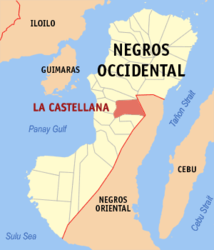La Castellana
| Municipality of La Castellana | ||
| Location of La Castellana in the province of Negros Occidental | ||
|---|---|---|

|
||
| Basic data | ||
| Region : | Western Visayas | |
| Province : | Negros Occidental | |
| Barangays : | 13 | |
| District: | 5. District of Negros Occidental | |
| PSGC : | 064517000 | |
| Income class : | 1st income bracket | |
| Households : |
May 1, 2000 census
|
|
| Population : | 74,855 August 1, 2015 census
|
|
| Population density : | 345.7 inhabitants per km² | |
| Area : | 216.51 km² | |
| Coordinates : | 10 ° 21 ′ N , 123 ° 4 ′ E | |
| Postal code : | 6131 | |
| Geographical location in the Philippines | ||
|
|
||
La Castellana is a municipality in the Province of Negros Occidental on the island of Negros in the Philippines . It has 74,855 inhabitants (August 1, 2015 census) who live in 13 barangays . It belongs to the first income bracket of the communities in the Philippines and is described as partially urbanized .
It is located approx. 67 km southeast of Bacolod City . Travel time is around 90 minutes by bus or jeepney . Its neighboring communities are La Carlota City , in the north, Guihulngan City , Canlaon City in the province of Negros Oriental in the east, Moises Padilla and Isabela form the southern border, Hinigaran and Pontevedra are to the west of the community. The topography of the municipality is described as mountainous, the municipality is located on the Kanlaon volcano .
The entrance to Mount Kanlaon Natural Park is at the Administration Center on the parish territory. The Tulo-Tulo Grotto is located in the Barangay Cabacungan, in it there are springs whose water is used for irrigation. The impressive Mandayao twin waterfalls are around 140 meters high and are located on the Kanlaon. The Mandayao Shell Cave has a cathedral-like grotto, whose stalactites glow in the dark and offer an impressive light show over the small lake that is located in the grotto.
Barangays
|
|
|
